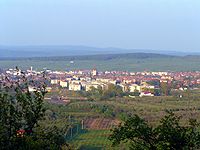- Cisnădie
-
Cisnădie — Town — 
Coat of armsLocation of Cisnădie Coordinates: 45°42′46″N 24°09′03″E / 45.71278°N 24.15083°ECoordinates: 45°42′46″N 24°09′03″E / 45.71278°N 24.15083°E Country  Romania
RomaniaCounty Sibiu County Status Town Government - Mayor Johann Krech[1] (Democratic Forum of Germans of Romania) Area - Total 138.56 km2 (53.5 sq mi) Population (2002) - Total 17,871 Time zone EET (UTC+2) - Summer (DST) EEST (UTC+3) Website Cisnadie.Ro Cisnădie (Romanian pronunciation: [t͡ʃisnəˈdi.e]; German: Heltau; Transylvanian Saxon dialect: Hielt; Hungarian: Nagydisznód) is a town in Sibiu County, Transylvania, Romania located approximately 10 km from Sibiu. As of 2002, it has a population of about 17,871. One village, Cisnădioara, is administered by the town.
Contents
History
Cisnădie was mentioned for the first time in a document from the year 1204 under the name "Rivetel". In the 12th century Saxon colonists settled here, and in 1323 the German name Heltau is mentioned. The town flourished, particularly the guilds of blacksmiths and wool weavers (weaving remained the traditional occupation of the town population until the 20th century, when large textile factories were built).
Cisnădie shared most of Transylvania's eventful history. The town suffered several raids, starting with the 1241 raid of the Mongols and continuing with Ottoman attacks. The plague did not spare the town, neither did the fire nor political agitations. In 1806 under Emperor Franz of Austria, Cisnădie/Heltau renewed its market rights, proving prosperity.
In 1945, large parts of the German population was deported to the Soviet Union (see also Expulsion of Germans from Romania after World War II).
In 1948 all factories were nationalized and run under the Communist regime. Along with its fall, most of the factories collapsed, but in the last years the economic situation has been ameliorating.
Demographics
According to the census from 2002 there was a total population of 15,648 people living in this town. Of this population, 96.07% are ethnic Romanians, 2.47% are ethnic Germans, 1.08% Hungarians and 0.23% ethnic Rroma.[2]
Sights
The most important architectural sight of Cisnădie is the fortified complex located in the town center. Originally built in the 12th century as a Romanesque basilica, the church was fortified during the 15th century, to protect the local population of Saxons against repeated Ottoman raids. The fortification process included the construction of fortified towers over the two side entrances and the choir, the building of a double structure of defence walls, a moat and several defensive towers along the walls. Simultaneously to the fortification work the church itself suffered a gothicization process. The altar inside the Lutheran church, which forms the center of this complex, is a wing altar/triptych from the 15th century, realized by the school of Veit Stoss Jr.
The complex is very well preserved and besides being a medieval architectural place of interest, it offers a variety of theme exhibitions:
- the "Cisnădie/Heltau throughout 12 centuries" Museum located over the old Ossarium
- the Museum of Medieval Defensive Structures located in the northern side tower
- the Museum of the History of the Communist Era
- some alternating Art Expositions.
Cisnădioara village
Cisnădioara (German: Michelsberg; Hungarian: Kisdisznód; Transylvanian Saxon dialect: Mächelsbärch) is a village located 2 km west of Cisnădie. Initially, it was listed as one of the ten possessions of the Cistercian abbey at Cârţa. The fortified church, built entirely of stone, was first referred to in a document dated November 20, 1223, which mentioned its donation to the abbey. The oldest Romanesque style church in Romania, it stands atop a 100-meter high hill, surrounded by circular fortifications, with a defensive turret above the entrance. Some of the original walls have been preserved to this day. The layout of the church, composed of a small basilica with three naves, as well as the decoration of the carved western entrance portal, dating from 1260, attest to the strong influence of Rhineland architecture.
Images
-
The romanesque church of Cisnădioara, built in the second half of the 12th century
Bibliography
- Augustin Ioan, Hanna Derer. The Fortified Churches of the Transylvanian Saxons. Noi Media Print, 2004
References
External links
- (Romanian) Official website
- (Romanian) Tur virtual 360 Cetatea Cisnadioara
- (German) Website of the Lutheran Parish - contains history of the fortified complex and description of the expositions
Sibiu County, Romania Cities 
Towns Agnita · Avrig · Cisnădie · Copşa Mică · Dumbrăveni · Miercurea Sibiului · Ocna Sibiului · Sălişte · Tălmaciu
Communes Alma · Alţâna · Apoldu de Jos · Arpaşu de Jos · Aţel · Axente Sever · Bazna · Bârghiş · Biertan · Blăjel · Boiţa · Brateiu · Brădeni · Bruiu · Chirpăr · Cârţa · Cârţişoara · Cristian · Dârlos · Gura Râului · Hoghilag · Iacobeni · Jina · Laslea · Loamneş · Ludoş · Marpod · Merghindeal · Micăsasa · Mihăileni · Moşna · Nocrich · Orlat · Păuca · Poiana Sibiului · Poplaca · Porumbacu de Jos · Racoviţa · Răşinari · Râu Sadului · Roşia · Sadu · Slimnic · Şeica Mare · Şeica Mică · Şelimbăr · Şura Mare · Şura Mică · Tilişca · Târnava · Turnu Roşu · Valea Viilor · Vurpăr
Categories:- Towns in Romania
- Populated places in Sibiu County
Wikimedia Foundation. 2010.







